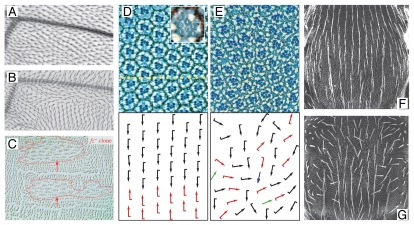Figure 1.
PCP phenotypes in Drosophila. (A and B) Enlarged view of part of an adult wild type (A) and stbm mutant (B) wing. Note the irregular wing hair swirls of the stbm mutant. Distal is to the left; anterior is up. (C) Trichomes on the cuticle of abdominal tergites. Note the posterior non-autonomy of fz mutant clones (outlined by red lines), where trichomes point anteriorly toward the clone (red arrows) instead of posteriorly. Image courtesy of P. Lawrence (adapted with permission).72 (D and E) Examples of wild type (D) and fz mutant (E) adult eye sections showing the semi-crystalline arrangement of ommatidia. The schemes below the sections indicate the polarity of ommatidia, with arrows drawn from R3 to R1 and the flag pointing toward R4. Note the randomized chirality and degree of rotation in the fz mutant. Yellow dots represent the equator. The insert in (D) is a high magnification of a single ommatidium with the photoreceptors numbered (R8 is below R7 and thus cannot be seen). (E and F) Scanning electron micrographs of the dorsal thorax of adult flies. (E) In wild type, thoracic bristles are well aligned and point toward the posterior. However, in a fz mutant (F), bristles are misaligned due to the random planar division axis of SOP cells. Images courtesy of P. Adler (adapted with permission).65

